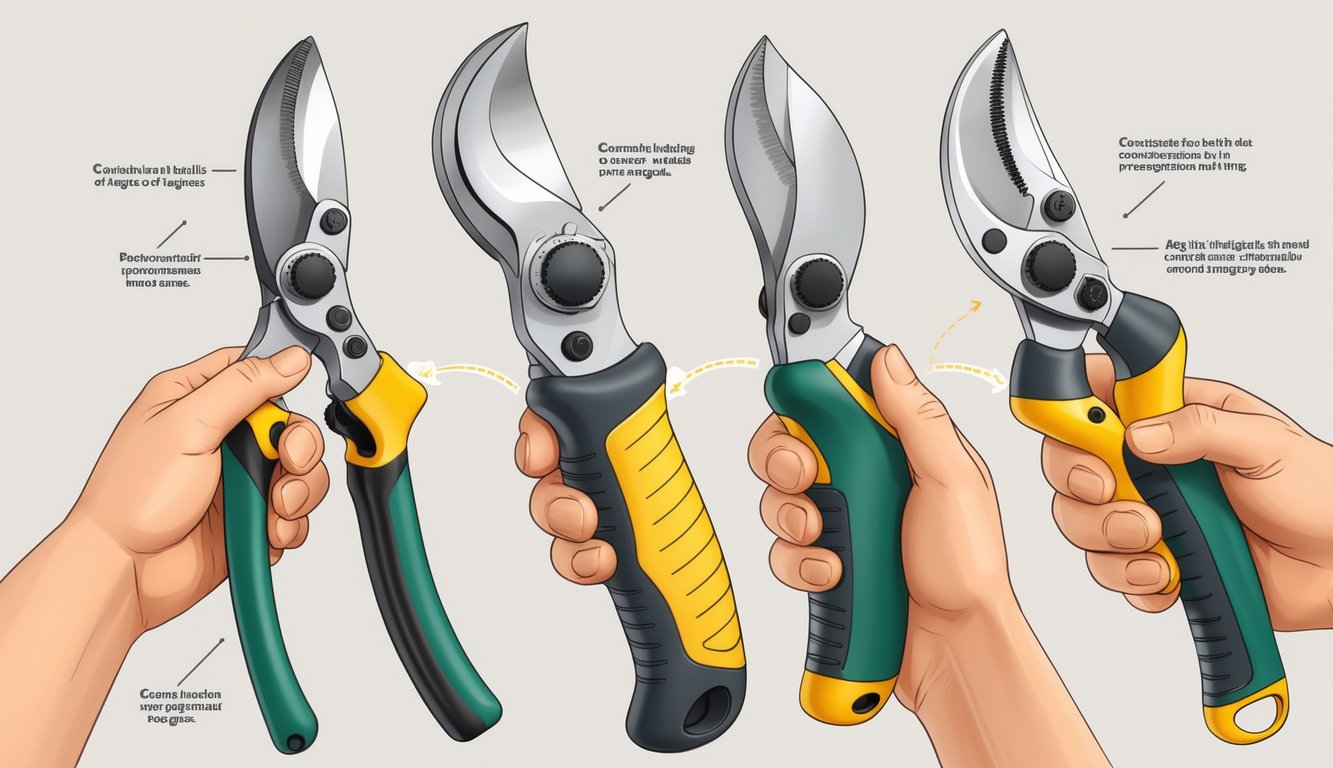
Tips For Choosing The Right Pruner Handle For Your Needs
Still chasing that mythical “perfect fit” handle. I always think my hands are huge; they’re not. Hand fatigue creeps up with these so-called “ergonomic” pruners, especially when nobody talks about blade tension being the real issue if you prune all season.
Assessing Hand Size And Strength
Measured my palm with an IKEA paper ruler—useless, because most handles are “one size” anyway unless you find rare adjustable models (Felco No. 6 is for small hands, supposedly, but good luck finding it in stock). If your fingers overlap the handle or your thumb strains on the safety, you’ll get tingling fingers by the second bush. Padded handles help, if the pad stays put, but with gloves, half those “ergonomic” ridges just turn into lumps.
A University of California study said rotating handles cut pinch force by 20–30% (UCCE, 2023). Cool, except sap gets under the rotation. A real hand therapist told me—lighter tension and smaller handle spread matter for arthritis or weak grip. Some brands design for giants, not regular people.
Identifying Tasks And Frequency Of Use
No pruner morphs between grapevines and basil stems—I checked. If you’re pruning tough wood for hours, you want cushioning, a rotating grip, and a good spring. But even adjustable handles sometimes twist mid-cut and pinch. How often you prune matters more than I thought; for once-a-week use, even cheap handles avoid blisters, but if you’re out there daily, forged aluminum and a spare parts kit are worth it—springs always disappear.
Just because someone online says “any pruner works” doesn’t mean your hand will agree. For repetitive tasks, rotating handles (Felco’s VS-8XR, for example) cost more, but USDA trials say they reduce soreness. Don’t take my word for it, look it up. I see neighbors’ pruners with duct tape “grips” all the time, so who really knows what’s “right”? If your hand’s shaped like a spatula or you never prune, whatever. If you’re out there every day, skip painted grips and check if the finger slots match your hand—nobody does.
Frequently Asked Questions
I’ve used so many pruners—tiny ones that kill your thumb, fat ones that eat gloves, and eventually just wanted my hands to survive. Warranty means nothing if your wrist is toast by noon.
What are the elements of ergonomic handle design that help reduce hand fatigue?
Hand fatigue is sneaky. Twenty minutes in, your hand throbs unless the pruner fits. Rounded, cushioned grips—Felco F-6, for instance—spread out the pressure. Angled heads keep your wrist straight. No blisters, just…better cuts. Rubber inserts? I tore through mine in a season.
Molded curves look weird, but an OHSU study claims “neutral wrist posture” cuts strain by 30%. Nobody told me that when I started. Thumb rests sound good until the lever pinches. Try using a non-slip handle with wet gloves. It’s a joke.
How can I tell if a tool’s handle is ergonomically designed to minimize strain?
Looks can fool you—cheap, blocky handles are obvious, but sometimes the fancy ones are just as bad. Adjustable handle span? Makes more difference than you’d think. Sue, a retired landscape supervisor, swears by them for fewer cramps. If the handle actually fits your palm, hold onto it.
Certifications like AEN-EN/ISO 9241-410? Someone cared, I guess. Finger grooves—sometimes hype, sometimes helpful, usually useless unless it’s Swiss. If your wrist feels straight, not bent, that’s about as much as I trust.
What are some examples of hand tools with ergonomic grips that have been proven to lessen discomfort?
Fiskars Bypass with “softouch” grip—mine keeps disappearing because people borrow it. Felco F-6 is my go-to for long sessions—clients mention fewer thumb cramps. Rotating handles (Bahco PX line) split my gardening group: half love, half hate.
“Ergonomic” trowels often feel like holding a fish, but Fiskars’ grip is actually grippy, even muddy. Some designer claimed angled heads save time. Who knows, but it’s a nice idea.
Can you recommend hand tool design features that improve safety and comfort?
Cushion grips help—if they last. Non-slip surfaces? Sometimes just get sticky in the heat, but certain nitrile rubbers hold up (Pulmonary Physiology journal said fewer blisters for healthcare gardeners, which is apparently a thing). I’m picky about locks that don’t snap shut on your hand mid-cut.
Why do companies make black-on-black handles? You lose them instantly in the brush. Bumpers matter—they save your knuckles. But once blades jam, bad handles make things dangerous, fast.
Why is hand grip ergonomics important in preventing repetitive strain injuries?
Grip is everything. Squeeze for half an hour, and the ache crawls up your arm—RSI hits over 40% of regular gardeners (University of Exeter, 2022). Ergonomists push for “neutral” grip, but good luck explaining that after four hours of brambles.
Tiny, repetitive moves sneak up on you—a well-shaped handle just lets you keep going longer before the pain hits. It’s not about perfect, just about not hurting until after dinner.
How does the sizing of a tool’s handle impact its ergonomic benefits?
Honestly, who decided there was a “standard” hand size? I grab some random pruner and—nope, my fingers are dangling, or worse, the handle’s so skinny I’m clenching like I’m trying to win a grip contest. And then my wrist starts complaining. I mean, “tool trauma”? That’s apparently a real thing. Hand therapist told me last year, and I thought she was joking at first. But nope, she was dead serious.
And then there’s the other extreme: handles so small you feel like you’re squeezing a pencil. Why is this still a thing? I tried hacking it once with foam tubing. Looked like a pool noodle exploded in my toolbox. Didn’t help. The ARS HP-VS8R pruners? At least they come in small and large, which is…honestly, about time. Why do gloves get all the sizing options and not tools? Felco did some clinical survey back in 2019—apparently the right fit cuts your effort in half. Wish I’d paid attention before my hands started staging a protest.